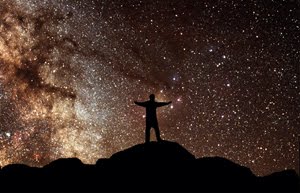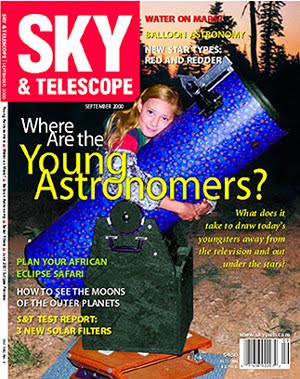November 2, 1996

The day began with dense low clouds blanketing the south San Francisco bay area. The prior night's weather reports were for clear skies and warming, but the result did not appear to support the forecasts. By mid day, I was getting phone calls from friends wondering if anyone was going to "the Peak" for the evening. Since the drive is only an hour, I remained optomistic, telling the callers that the clouds would dissipate later in the day. By 1:30 I was packed and on the road. I could hardlly believe I got the 14.5" dob, ladder and all my other equipment into a four door sedan (I usually drive a large truck).
The sky really looked bad... solid thick clouds to the north, and the range to the south, where the Peak is located, was not visible at all as I approached the halfway mark of the drive. Still, the sky above was beginning to open up, and there was little wind. It was the promise of a thick fog layer over the city lights that drove me onward.
I was the second member of the "club" to arrive atop the Peak. We unpacked and talked, my friend unloading his 10" dob. We watched the sky continue to open. Our view of the Pacific Ocean was that of fog... a thick.... light killing banket covering Watsonville, Santa Cruz to the north and south to Monterey. Things were looking better.
Soon, another friend arrived. Out came the 7" Questar and Astrophysics Traveller. The Traveller was placed on a nice Vernon Scope / Unitron alt/az mount. The clouds began moving out to sea, leaving only the fog layer. :-) Up pulled a nice little Mitsubishi 3000, and out came a Tele Vue Pronto. The owner of the Pronto had left his 12" LX-200 home, since the sky looked so bad when he left. Next to arrive was the "first-light" scope for the night, a 7" AstroPhysics f/9 EDT APO on an AstroPhysics 800 mount. What a piece of equipment! The final two members of the group pulled up with an 18" f/4.5 Obsession and a 8" Meade LX-200.
As the sun set, the temperatures began dropping rapidly. Only one band of clouds remained to the west. Jupiter showed a great deal of banding detail, but the air was turbulent just over the right shoulder of Fremont Peak, and the views were unsteady. Smaller aperture reduced the effects... my dob was not seeing the planet well. Too bad... that banding was very distinct!
Next, to the east, Saturn. The night before, from my backyard in Los Gatos (bordering San Jose), I was able to see the Cassini division and clear banding. Tonight, the banding was still there, nice cream colors. I could not see Cassini though, since the air was still unsteady while day changed to night. However, we did see five or six of Saturn's moons. The sixth one was a "maybe-sometimes" observation.
Once dark had really arrived, it was obvious we were in for one of the better nights in recent years at the Peak. The "dark" at the Peak cannot compete any longer with truly dark sites, as the bay area light dome continues encroaching southward, but it can still be quite good seeing.
Out to the west, the fog had small islands of dim white below. The lights of the coastal cities would not be a factor in our observing. To the north, the light dome of San Jose was greatly reduced... it was a huge improvement. To the south, Salinas threw some light, but it was mostly blocked by Fremont Peak. The rest of the sky opened up such that we would could see the dark "blotches" of dust cloud in the Milky Way north of Deneb in Cygnus. It was turning into a great night.
I began working Hershel objects, mostly galaxies, with my 14.5", my friend with his 18". This was easy! It was too bad the moon had to come up (although, a few of the other observers, whose preferences are lunar and planetary, did not seem to share our concern).
Between 7pm and 11:15pm, we "bagged" roughly 20 Herschels. We worked almost exclusively in Aquarius, and finished the constellation (which we had begun last year) with the exception of one mag 15 stellar galaxy. We hit two that were dimmer than mag 14.5, with most in the range of 13.5 to mag 14.
Several of the galaxies were in groups. A great site that I would recommend deep sky observers take the opportunity to view is the grouping of NGCs 7180, 7185, 7188 and 7184. NGC 7184 is big and bright (NGP and _The_Sky_ list it at mag 12, 6.0" x 1.5" approx.). It shows nice easily seen features. The others, all small in comparison, are in the same wide-field view, and range from mag 12 to mag 14. Another galaxy sits just outside the field, glowing dimly at mag 14.4.
In between viewing, our group all enjoyed the comraderie that accompanies a good night among friends. A lot of chatter, a couple enhanced coffees, joking and needling each other about equipment.... along with the usual discussions about how to observe and the merits or failings of various equipment.
It was a relaxed evening. I was asked several times to put the 14.5" on some of the brigher objects... M35, M42, Hale-Bopp, M2, M13, Gamma Andromeda, M74, M33, the Eskimo Nebula, the Helix, the Blue Snowball, M31/32/ngc110, ngc404, double cluster, ngc787 9 (Cass), ngc7006 (Del), ngc 7331, M15.
One thing I like to do when out with other observers, is to familiarize them with hunting the faint stuff (no, I am not a dim-Hickson expert), as developing the ability to detect some of the almost "aint-no" stuff improves visual accuity, helping us see more detail in the somewhat brighter objects. It is also fun to challenge yourself by trying to locate (without electronics) these dim objects. In most cases, it is possible to move naked eye to within roughly one degree of an object, and pull it in with a wide-field eyepiece (I use a 20mm wide-field). Occasionally, I find it is necessary to use my friend's laptop computer and planetarium program, zooming in on the object to identify the pattern of field stars.... but this is usually only when the object is so dim that you have to use the field stars as reference to know where to avert your eyes to!
But, back to the evening... too soon for me, the moon's orange smile shown over the peaks to the east, showing between the branches and remaing leaves of the trees. We had noticed earlier the sky beginning to brighten to the east. To bad for us dark sky types. We poked around for a bit longer, looking at M81 and M82. Some said they looked good... which would be true if viewed from in town. But the moon-glow was washing them out badly. Everyone except the Pronto, Traveller and 7" APO were in the process of or already torn down. The views of Saturn, now up high in the south, were breathtaking (7" APO). Titan sat atop one of the poles of the planet. The rings were nicely detailed. The sharpness of the image could not have been greater. What a machine, and what a night. A quick swing over to the moon, looking at Birts Rill and the spiked peaks casting sharp shadows on the crater floors along the terminator, well, you had to be there! Maybe next time you will.
Bay area observers, you are invited to e-mail me about our next star party. Those in other cities and countries, get out there.... there is *nothing* that replaces a dark sky for observing!











